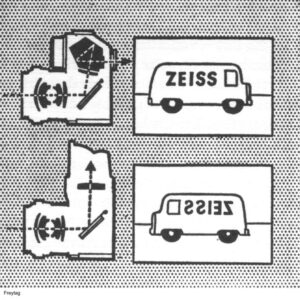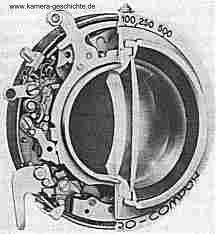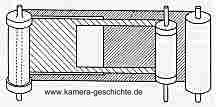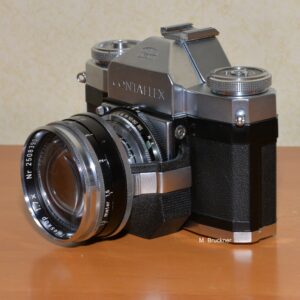SLR Cameras
What exactly is a SLR camera?
As the name suggests, there is a mirror in it and it reflects something. Namely the light beam that comes through the lens, via a pentaprism in the direction of the viewfinder. Why this effort? Because this makes the viewfinder image appear upright and the right way round, no matter which lens is being used. When the film is exposed, the mirror is folded up and the camera shutter opens. Here as Example of a cross-section through the Contaflex I,  the first West German SLR camera with a central shutter and a preselectable diaphragm, i.e. the diaphragm is preselected and jumps to the set value at the moment of exposure. The advantage of this is that the viewfinder image always appears evenly bright. The first SLR cameras already existed in the 1930s. Initially as twin-lens cameras such as the Rolleiflex from Franke & Heidecke, or the Ikoflex from Zeiss Ikon. With these cameras, the viewfinder and recording lens were separate, and the viewfinder was viewed via an overhead light shaft.
the first West German SLR camera with a central shutter and a preselectable diaphragm, i.e. the diaphragm is preselected and jumps to the set value at the moment of exposure. The advantage of this is that the viewfinder image always appears evenly bright. The first SLR cameras already existed in the 1930s. Initially as twin-lens cameras such as the Rolleiflex from Franke & Heidecke, or the Ikoflex from Zeiss Ikon. With these cameras, the viewfinder and recording lens were separate, and the viewfinder was viewed via an overhead light shaft.
 Here is a scheme for clarification: While the image appears upright on the reflex camera (single-eyed here) with a waist-level viewfinder, on the camera with a pentaprism everything is optically in its right place. Another feature is the type of closure. A distinction is made between central and focal plane shutters. (Other types of closures, e.g. roller closures, rarely occur in practice).
Here is a scheme for clarification: While the image appears upright on the reflex camera (single-eyed here) with a waist-level viewfinder, on the camera with a pentaprism everything is optically in its right place. Another feature is the type of closure. A distinction is made between central and focal plane shutters. (Other types of closures, e.g. roller closures, rarely occur in practice).
 As an example, a Synchro-Compur central shutter as used in a similar design on the Contaflex. With all central shutters, slats arranged in a circle jump from the inside to the outside (similar to the iris diaphragm) and back again when the shutter is released. The full lens opening is released with every exposure time, which is advantageous when working with the flash unit. Another plus is the relatively low price of this design.
As an example, a Synchro-Compur central shutter as used in a similar design on the Contaflex. With all central shutters, slats arranged in a circle jump from the inside to the outside (similar to the iris diaphragm) and back again when the shutter is released. The full lens opening is released with every exposure time, which is advantageous when working with the flash unit. Another plus is the relatively low price of this design.
 With the focal plane shutter, two curtains are pulled past the film surface at a short distance one behind the other, as in the picture on the left. The time interval determines the shutter speed. The greatest advantages of focal plane shutter cameras are the simplicity of changing the lens, which is hardly subject to focal length restrictions and the possibility of achieving times faster than 1/500 sec. The disadvantages: fairly complex construction (especially the accuracy of the curtain control), masses moving quickly in one direction (likely to lead to camera shake), flash synchronization only possible with relatively long times. (1/30-1/60sec) As has been found over the years, focal plane shutter control was and is the optimal solution even in today’s digital reflex cameras. The original design with horizontally running rubber blankets has almost universally been superseded by a vertical metal closure. The central shutter only plays a role in medium format cameras, where it is integrated into the lens to be changed.
With the focal plane shutter, two curtains are pulled past the film surface at a short distance one behind the other, as in the picture on the left. The time interval determines the shutter speed. The greatest advantages of focal plane shutter cameras are the simplicity of changing the lens, which is hardly subject to focal length restrictions and the possibility of achieving times faster than 1/500 sec. The disadvantages: fairly complex construction (especially the accuracy of the curtain control), masses moving quickly in one direction (likely to lead to camera shake), flash synchronization only possible with relatively long times. (1/30-1/60sec) As has been found over the years, focal plane shutter control was and is the optimal solution even in today’s digital reflex cameras. The original design with horizontally running rubber blankets has almost universally been superseded by a vertical metal closure. The central shutter only plays a role in medium format cameras, where it is integrated into the lens to be changed.

Here the world’s first single-lens reflex camera with central shutter and preselection spring diaphragm, the Contaflex I here with attached telescope.
Introduced in 1954, its solid construction, automatic open aperture and bright viewfinder image made it very successful in sales. A disadvantage from the point of view of many buyers was that no interchangeable lenses were provided. (1955 came the telescopic attachment shown here, which resulted in a focal length of about 80mm)
This shortcoming was only changed with the successor models Contaflex III and IV with the help of set lenses.
Continue with: SLR with central shutter or start page
